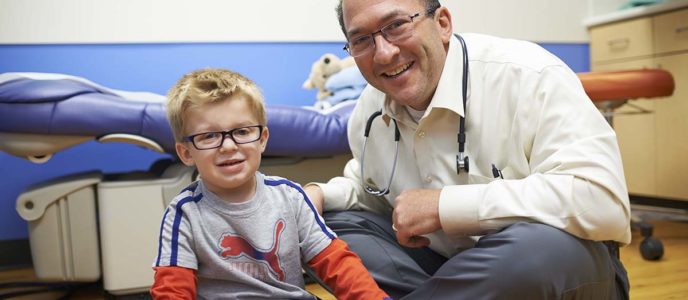Liver cancer happens when cancer cells develop in the tissue of the liver, forming solid tumors. The common form, hepatocellular carcinoma, is more common in adults than children. Hepatoblastoma, the common form for liver cancer in children, occurs in about 1 in 1.5 million kids in the U.S. Typically it is diagnosed in children less than three years of age. Children will develop a mass in their bellies and have discomfort, poor appetite, and weight loss.
Most children with hepatoblastoma can be cured and will go on to live fulfilling lives. However, some children require newer therapies in the battle for a cure, which is not always successful. Some survivors may have scars following treatment, such as hearing loss.
Because I am asked a lot of questions about the disease in our Liver Tumor Program, I thought it might be helpful to answer some of the most frequent ones I receive:
Hepatoblastoma in Kids: Most Frequently Asked Questions
1. Is a cure possible?
The good news is that if hepatoblastoma is caught in the early stages, with the right treatment, about 90% of patients can be cured. If caught in the late stages, or if it relapses, there is still a chance for cure, perhaps exceeding 50%.
2. What treatments will my child need?
At our Liver Tumor Program, each patient undergoes an extensive evaluation with multiple disciplines to develop an individualized treatment plan. Our specialists utilize established knowledge from prior studies in hepatoblastoma. Treatment can include chemotherapy, surgery to resect tumors, liver transplantation, biologic therapies, radiofrequency and/or cryo-ablation, and transcatheter arterial chemo- or radio-emobilization.
3. Will my child need a transplant?
Hepatoblastoma is the most common tumor for which a solid organ transplant is considered as a possible treatment. In fact, liver transplant is a treatment for one in five children with hepatoblastoma. That said, it really depends on your child’s specific situation.
4. Why did my child get this type of cancer?
We often don’t know the cause or reason why your child has been diagnosed with cancer. This can be understandably frustrating. We do, however, have some theories. One is that we believe hepatoblastomas in childhood come from cells that didn’t quite develop in the right way. This irregular growth may happen in utero through the first few years of life. This has nothing to do with factors related to the mother during the pregnancy that we can identify.
What we do know is that there are certain risk factors that make your child more likely to get hepatoblastoma. One is prematurity. 1 in 5 kids with hepatoblastoma are born before 30-32 weeks of gestational age. Unfortunately, we haven’t discovered why there is a link. More rarely, a genetic condition such as Beckwith-Weidemann syndrome or familial adenomatous polyposis, may be associated with hepatoblastoma. Combined, known genetic causes likely account for less than 10% of hepatoblastoma cases.
5. Is there a high relapse rate?
The rate of relapse depends upon what stage your child’s cancer was at the time of diagnosis, and other ‘risk factors’ such as aggressive histology subtypes (appearance under the microscope). For children who have localized cancer, the relapse rate is around 10-15%. If they have stage 4 or higher, the rate of either not getting rid of all of the cancer or relapsing after all measurable cancer has disappeared, may approximate 50%.
6. My child is developing hearing loss. How do we manage therapy in this situation?
earing loss can be a side effect of certain medications (cisplatin) that we need to use for treatment. Sodium thiosulfate is a chemical that may help prevent cisplatin-induced hearing loss in some children. There are theoretical concerns that sodium thiosulfate may also protect the tumor from the chemotherapy. This decreases the chemotherapy’s good effects as well as bad effects. You can discuss the relative risks of using sodium thiosulfate for this purpose with your physician. In general, we do not recommend use of sodium thiosulfate for children with metastatic disease, and its effects have not been studied in children with hepatoblastoma who receive very little cisplatin. We encourage careful monitoring of hearing function with cisplatin, as hearing aids (amplification) can greatly enhance a child’s hearing and growth and development, especially in the important early years of life.
7. My child finished therapy. Should she have further imaging done?
The literature says no, further imaging is not necessary since blood tests (alphafetoprotein, or ‘AFP’ for short) are thought to eventually detect most, if not all, relapses. However, there are a few situations in which I will still do it. The Europeans published old data suggesting that relapse can be detected with a normal AFP in 15% of cases. That data is rather old, and included children who did not have abnormal AFP to begin with (probably not all hepatoblastomas).
At our center, in those who had relapse detected (whether treated at our center or elsewhere), we have detected relapse by imaging with a normal AFP in 10% of the cases, though the AFP did eventually rise. Thus, I think it is possible to pick up a small relapse with imaging before an AFP rises. Most of the time, such small changes in the tumor size – from the time when it is not producing enough AFP to the time that it is – will not be clinically meaningful. That is, the delay in finding the relapse will not impact the chances for the child to be cured at relapse.
However, in situations where I think detecting small relapses may be important, I prefer to use some imaging. Examples include children with hepatoblastoma who have residual findings on imaging (scars in the lung, for example); children who required liver transplant; children whose tumor ruptured (bled into the abdomen and pelvis); and children who have aggressive features under the microscope that reflect subtypes that may not produce a lot of AFP.
8. Where should I take my child for care?
If you’re able to get your child to a specialty center, such as our Liver Tumor Program or others throughout the country, your child may have the best chance at fighting and beating this disease. Children with hepatoblastoma need comprehensive, multidisciplinary care, preferably by those with experience seeing the various ways in which hepatoblastoma can behave. This requires coordination between oncology, sometimes hepatology, radiology, surgery, gastroenterology, nutrition therapy, nursing, and more.
To learn more about our Liver Tumor Program, please call 513-517-2234 or fill out an online form for more information.



Thank you Dr. Geller for putting this information together in a straight-forward format. I think this information will be extremely helpful for parents of newly diagnosed children and for those who are already receiving treatment. I think one of the most important things a parent can do is to find the right medical team with a comprehensive and integrated approach to treatment of liver tumors. Cincinnati is certainly among the best places to seek treatment and expert consultation. Were are forever grateful for your expertise, wisdom and caring approach to our liver tumor kiddos, and for your willingness to reach out far beyond the walls of any one treatment facility.
The Clayton Family (parents of relapsed/refractory Hepatoblastoma survivor)